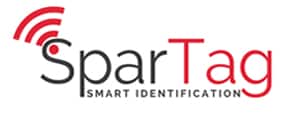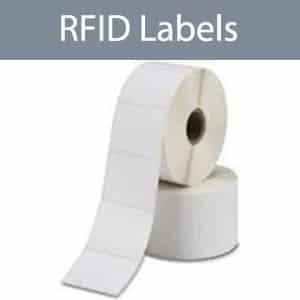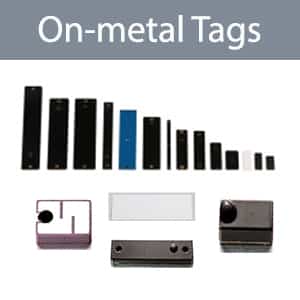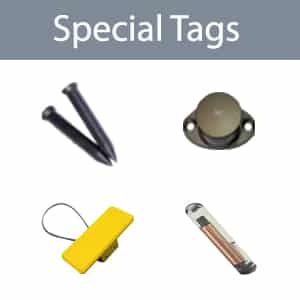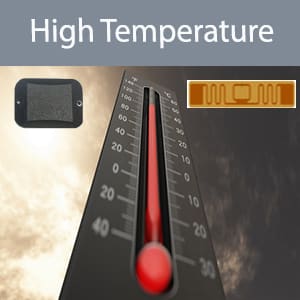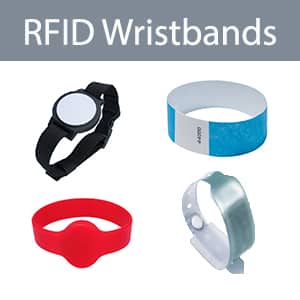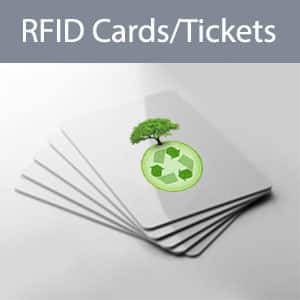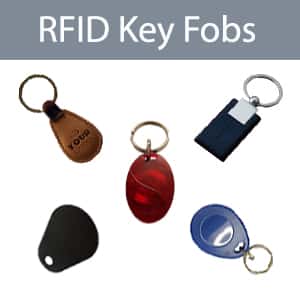RFID tags:
RFID tags or RFID labels associated with an RFID reader will exchange data via radio identification, RFID means (Radio Frequency Identification), this tracking technology allows to receive data stored on the chips of identifiers called radio tags or more commonly RFID tags/labels or RFID transponders/labels. They are composed of a chip and an antenna forming what is called “Inlay”, it will then be encapsulated to form the tag in its various forms and according to the customer’s need. UHF RFID tags can be passive, semi-passive, battery-assisted passive (BAP) or active. Most passive RFID tags are UHF, they use the electromagnetic energy received from the reader to power up and transmit its own data back to the reader, passive RFID tags don’t have an internal source of power, it only uses the power received from the reader. Active UHF RFID tags uses an internal battery, so it can have way more reading distance than passive RFID tags thanks to the additional power delivered by the battery and the antenna size.
These small objects designed around a antenna and microchip called RFID tags/labels, can be attached to products to be identified via different types of adhesives, they can also be screwed or placed via a magnet built into the RFID tag on metal surfaces if you want to set up identification solutions consisting of a reader and a tag or several reusable tags for example. The (UHF, HF or LF) RFID chip data can be read or written using mobile or fixed readers, this code is called the Electronic Product Code (EPC) for UHF RFID tags and corresponds to the products to be identified, you can alos lock data on the RFID tag memory area so the customer can nor delet or write any data on it, for this, you need to chose the right chip technology.
Choosing RFID tags:
The choice of the RFID tag or RFID labels depends on the reading distance required (antenna size), the chip needed, the attachment mode (screw, adhesive), the type of surface (metallic, plastic, other..), the associated readers as well as the level of robustness. If the application requires a large reading distance (up to 10m) as for industry 4.0, logistics, retail, jewelry …) UHF RFID passive technology (860MHz-920MHz) should be used, if more than 20m reading distance is required, UHF RFID active tags should be used for more power so that data can be sent at a greater distance ; If the application requires a reading on contact with the tag or few cm, you may use NFC/HF 13.56MHz or low frequency RFID chip (125KHz or 134.2KHz) technology. Chosing between all these frequencies can also be for cost reasons, in fact, the use of a paper or hardened label based on one frequency or another can greatly vary its price. Also, each frequency band corresponds to a given area of activity, for example, the 125KHz and 134KHz RFID frequencies are reserved for access control and animal identification or tracking.
RFID Tag memory size:
In most cases, RFID tags or RFID labels will have a sufficient size to store the product EPC tracking number, this code will be uploaded to the database and then processed by the application software. In the case of isolated areas, access to the database is impossible, so RFID tags/labels must contain the necessary information directly into the chip, in this case, a larger memory size should be used and the data read will be saved in the UHF mobile reader.
SparTag offers a wide range of readers and passive RFID tags/labels incorporating a chip that works on a given frequency band (UHF 860MHz-920MHz, HF 13,56MHz or LF 125KHz/134KHz) and usable in various application areas such as inventory or tracking for Industry 4.0, logistics, textile industry and laundries, access control… Ect. The choice of RFID tags or RFID labels and the reader depends on several environmental elements, SparTag help you for the choice of the RFID tags, the associated chip and antenna size as well as the reader and ensures optimal and reliable operation both from the mechanical point of view as well as the security of the data.
For more information about passive/active RFID technology used for product tracking or inventory, please contact us.
